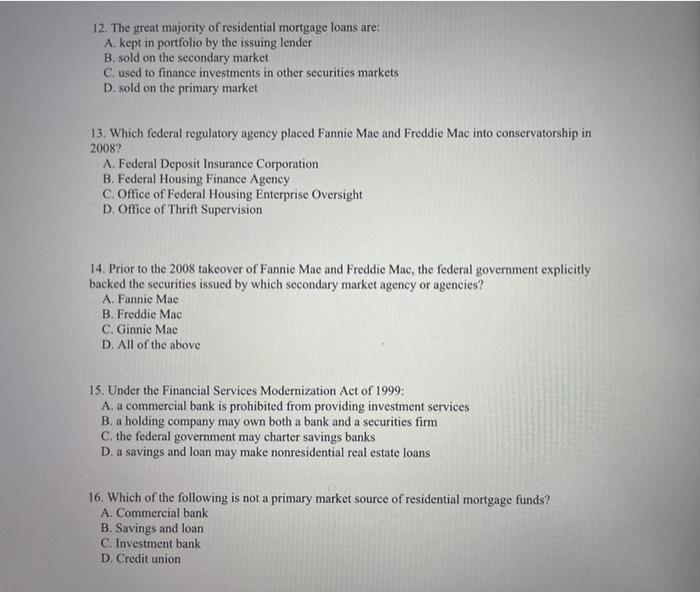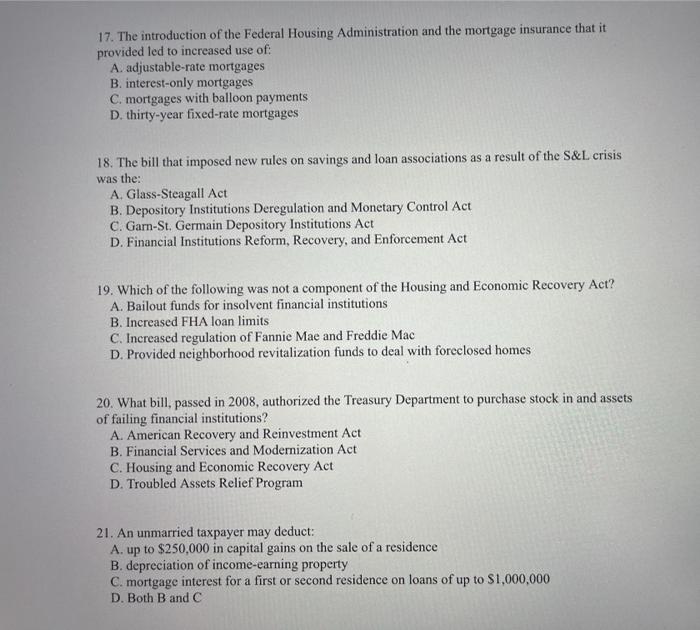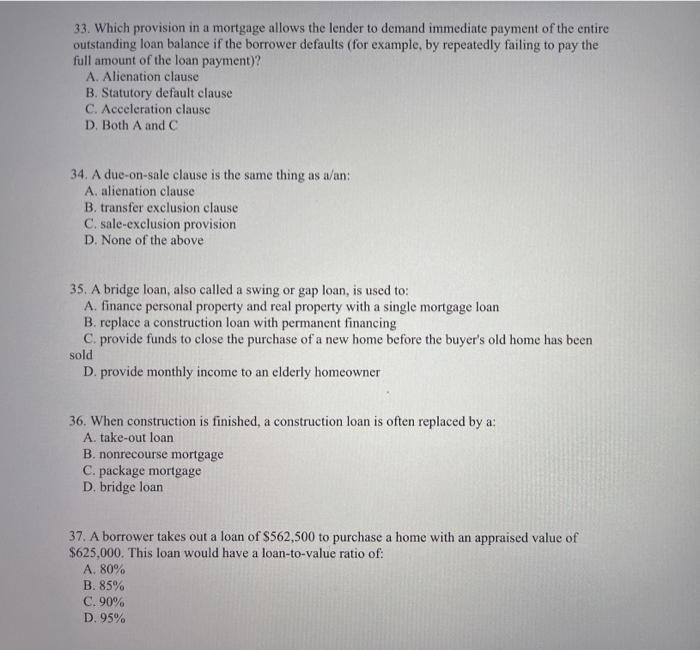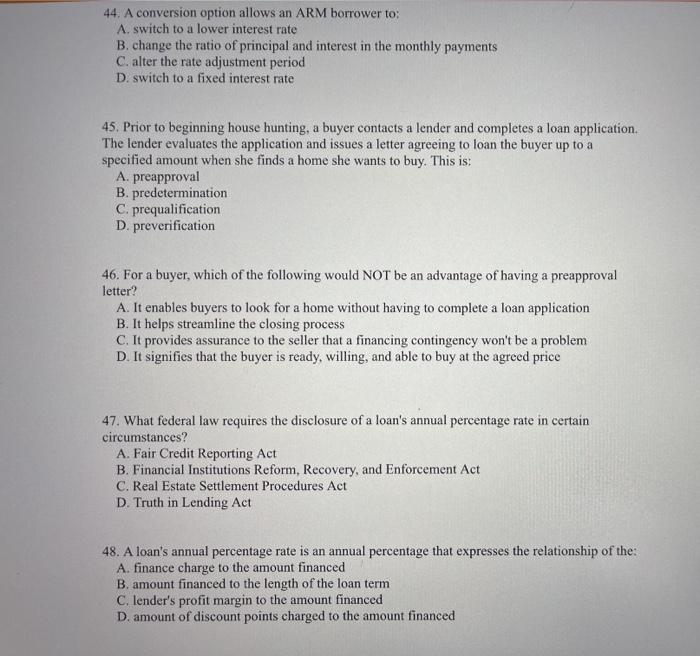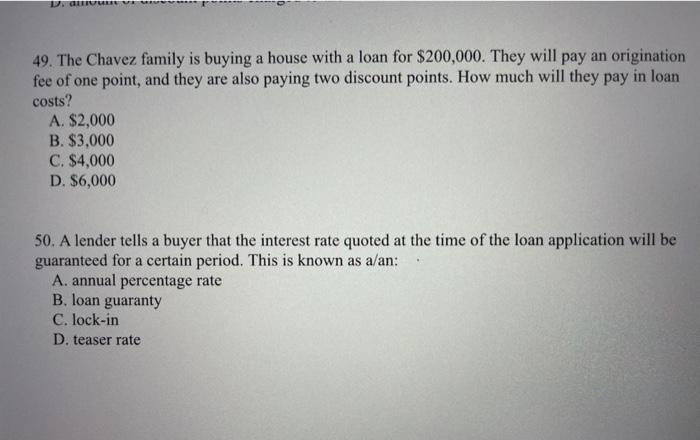please help me with these.
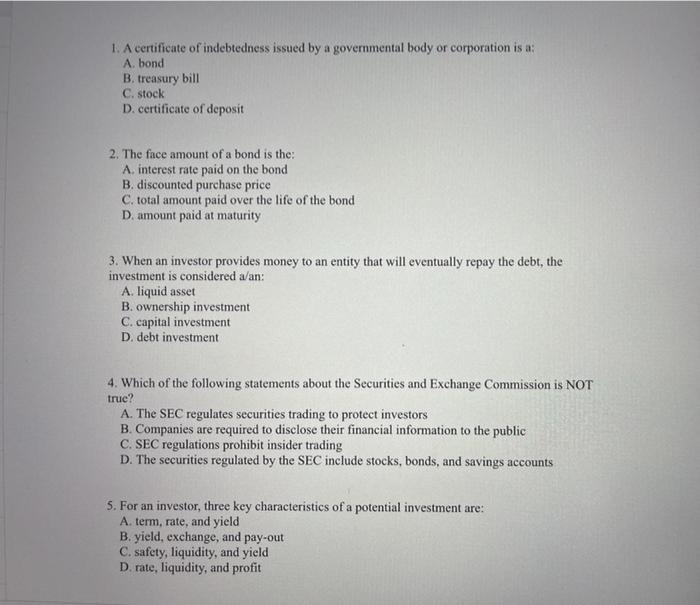
1. A certificate of indebtedness issued by a governmental body or corporation is a: A. bond B. treasury bill C. stock D. certificate of deposit 2. The face amount of a bond is the A. interest rate paid on the bond B. discounted purchase price C. total amount paid over the life of the bond D. amount paid at maturity 3. When an investor provides money to an entity that will eventually repay the debt, the investment is considered a/an: A. liquid asset B. ownership investment C. capital investment D. debt investment 4. Which of the following statements about the Securities and Exchange Commission is NOT true? A. The SEC regulates securities trading to protect investors B. Companies are required to disclose their financial information to the public C. SEC regulations prohibit insider trading D. The securities regulated by the SEC include stocks, bonds, and savings accounts 5. For an investor, three key characteristics of a potential investment are: A. term, rate, and yield B. yield, exchange, and pay-out C. safety, liquidity, and yield D. rate, liquidity, and profit 6. To minimize the risk of lower yields, lenders sometimes charge a penalty for: A. prepayment B. foreclosure C. increased interest rates D. None of the above 7. Generally, the longer the loan term: A. the lower the total interest paid B. the lower the interest rate C. the lower the interest rate risk D. the higher the interest rate risk 8. Disintermediation is caused by changes in: A. the national supply of mortgage funds B. the local supply of mortgage funds C. the national interest rates and investment yields D. the local interest rates and investment yields 9. The primary mortgage market was originally a: A national market made up of large financial conglomerates B. local market made up of local lending institutions C. national market made up of local lending associations D. local market made up of financial cooperatives 10. Mortgage-backed securities are: A. guaranties B. collateral C. investment instruments D. mortgage instruments 11. The underwriting guidelines established by Fannie Mae and Freddie Mac: A. have a minimal impact on lending standards in the primary market B. have a significant impact on lending standards in the primary market C. provide lenders with sample forms and standards D. None of the above 17. The introduction of the Federal Housing Administration and the mortgage insurance that it provided led to increased use of: A. adjustable-rate mortgages B. interest-only mortgages C. mortgages with balloon payments D. thirty-year fixed-rate mortgages 18. The bill that imposed new rules on savings and loan associations as a result of the S&L crisis was the: A. Glass-Steagall Act B. Depository Institutions Deregulation and Monetary Control Act C. Garn-St. Germain Depository Institutions Act D. Financial Institutions Reform, Recovery, and Enforcement Act 19. Which of the following was not a component of the Housing and Economic Recovery Act? A. Bailout funds for insolvent financial institutions B. Increased FHA loan limits C. Increased regulation of Fannie Mae and Freddie Mac D. Provided neighborhood revitalization funds to deal with foreclosed homes 20. What bill, passed in 2008, authorized the Treasury Department to purchase stock in and assets of failing financial institutions? A. American Recovery and Reinvestment Act B. Financial Services and Modernization Act C. Housing and Economic Recovery Act D. Troubled Assets Relief Program 21. An unmarried taxpayer may deduct: A. up to $250,000 in capital gains on the sale of a residence B. depreciation of income-earning property C. mortgage interest for a first or second residence on loans of up to $1,000,000 D. Both B and C 22. In contrast to wholesale lenders, retail lenders: A. deal directly with loan applicants B. generally work with loan correspondents C. focus on conventional loans D. tend to be large, nationwide institutions 23. Which of the following is not an aspect of the federal government's fiscal policy? A. Debt financing B. Government spending C. Setting key interest rates D. Taxation 24. Loans sold to a secondary market agency must: A. have been held in portfolio for a probationary period B. comply with the agency's underwriting rules C. be underwritten by the secondary market agency D. be sponsored by an independent investor 25. Because the Federal Reserve will provide short-term emergency loans to banks who can't meet reserve requirements, it is known as a: A lender of last resort B. primary market lender C. secondary market entity D. wholesale lender 26. In the early 1980s, the problem facing the economy that the Federal Reserve tried to resolve was: A. budget deficits B. low savings rates C. high and volatile interest rates D. stagnant growth 27. The interest rate charged by the Federal Reserve System to member banks who borrow funds to cover shortfalls is the: A discount rate B. federal funds rate C. open market rate D. reserve rate 28. To lower interest rates, the Federal Reserve would: A. decrease reserve requirements and buy government securities B. decrease reserve requirements and sell government securities C. increase reserve requirements and buy government securities D. increase reserve requirements and sell government securities 29. A note that requires payments of principal and interest is called a/an: A. straight note B. annual note C. installment note D. interest note 30. The interest paid on a real estate loan is almost always: A. compound interest B. variable interest C. simple interest D. None of the above 31. The power of sale clause in a deed of trust: A. authorizes the borrower to sell the property B. gives the trustee the power to sell the property judicially C. authorizes the trustee to sell the property in a trustee's sale D. None of the above 32. A satisfaction of mortgage is a/an: A. instrument given to the mortgagee when the mortgage is executed B. document recorded with the county to validate the mortgage C. instrument that releases the property from the mortgage lien D. document that establishes the lien priority of the mortgage 33. Which provision in a mortgage allows the lender to demand immediate payment of the entire outstanding loan balance if the borrower defaults (for example, by repeatedly failing to pay the full amount of the loan payment)? A. Alienation clause B. Statutory default clause C. Acceleration clause D. Both A and C 34. A due-on-sale clause is the same thing as a/an: A. alienation clause B. transfer exclusion clause C. sale-exclusion provision D. None of the above 35. A bridge loan, also called a swing or gap loan, is used to: A. finance personal property and real property with a single mortgage loan B. replace a construction loan with permanent financing C. provide funds to close the purchase of a new home before the buyer's old home has been sold D. provide monthly income to an elderly homeowner 36. When construction is finished, a construction loan is often replaced by a: A. take-out loan B. nonrecourse mortgage C. package mortgage D. bridge loan 37. A borrower takes out a loan of $562,500 to purchase a home with an appraised value of $625,000. This loan would have a loan-to-value ratio of: A. 80% B. 85% C. 90% D. 95% 38. All of the following are disadvantages of a longer loan term, except: A. the borrower's equity builds slowly B. the monthly payments are lower C. the borrower pays more total interest over the loan term D. the interest rate on the loan is higher 39. To use secondary financing, a borrower generally must: A. pay all of the downpayment with personal funds B. qualify for the combined payments on both loans C. pay the primary lender an additional fee D. have a loan guaranty for the second mortgage 40. In the event that the proceeds of a foreclosure do not cover the remaining balance on the loan, the mortgage insurer will pay the: A. lender the entire loan balance B. borrower the entire loan balance, plus foreclosure costs C. lender the shortfall D. borrower the shortfall 41. An ARM's margin is: A. the difference between the interest rate cap and the interest rate charged B. the difference between the index rate and the interest rate charged C. the difference between the mortgage payment cap and the interest rate charged D. None of the above 42. The initial interest rate for an ARM is also called the A. discount rate B. margin C. credit rate D. note rate 43. A life-of-loan cap A. restricts the amount of the monthly payments over the loan term B. limits the amount the interest rate may increase each adjustment period C. limits the amount the interest rate may decrease over the life of the loan D. None of the above 44. A conversion option allows an ARM borrower to: A switch to a lower interest rate B. change the ratio of principal and interest in the monthly payments C. alter the rate adjustment period D. switch to a fixed interest rate 45. Prior to beginning house hunting, a buyer contacts a lender and completes a loan application The lender evaluates the application and issues a letter agreeing to loan the buyer up to a specified amount when she finds a home she wants to buy. This is: A. preapproval B. predetermination C. prequalification D. preverification 46. For a buyer, which of the following would NOT be an advantage of having a preapproval letter? A. It enables buyers to look for a home without having to complete a loan application B. It helps streamline the closing process C. It provides assurance to the seller that a financing contingency won't be a problem D. It signifies that the buyer is ready, willing, and able to buy at the agreed price 47. What federal law requires the disclosure of a loan's annual percentage rate in certain circumstances? A. Fair Credit Reporting Act B. Financial Institutions Reform, Recovery, and Enforcement Act C. Real Estate Settlement Procedures Act D. Truth in Lending Act 48. A loan's annual percentage rate is an annual percentage that expresses the relationship of the: A. finance charge to the amount financed B. amount financed to the length of the loan term C. lender's profit margin to the amount financed D. amount of discount points charged to the amount financed VULVE 49. The Chavez family is buying a house with a loan for $200,000. They will pay an origination fee of one point, and they are also paying two discount points. How much will they pay in loan costs? A. $2,000 B. $3,000 C. $4,000 D. $6,000 50. A lender tells a buyer that the interest rate quoted at the time of the loan application will be guaranteed for a certain period. This is known as a/an: A. annual percentage rate B. loan guaranty C. lock-in D. teaser rate



